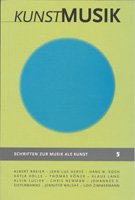Inhalt: #5 - Herbst 2005
ALBERT BREIER
MUSIK ALS KUNST DER ZEIT
JEAN-LUC HERVÉ
DIE MUSIK UND IHR BIOTOP
HANS W. KOCH
MÄRCHEN VON DER MUSIK ALS ABWESENHEIT VON KLANG
KATJA KÖLLE
SCHOTTISCHE GÄRTEN
THOMAS KÖNER
LE SILENCE AU FOND DE L‘ABÎME
KLAUS LANG
GROSSE EINFALT. THEATER UND ANTIKE.
ALVIN LUCIER
ORIGINS OF A FORM
ACOUSTICAL EXPLORATION, SCIENCE, AND INCASSANCY
CHRIS NEWMAN
FEBRUARY AND MARCH
JOHANNES S. SISTERMANNS
LUFTFLIESSEN
JENNIFER WALSHE
POPULAR TIMBRE FAMILIY TREES
UDO ZIMMERMANN
ZUR ZUKUNFT DER OPER
On September 24, 1960, I attended a concert by John Cage, David Tudor, Merce Cunningham, and Carolyn Brown at the Teatro la Fenice in Venice. I had come to Venice that summer on a Fulbright Scholarship to study at the Benedetto Marcello Conservatory before going on to Rome where I would spend the next two years. The Cage-Tudor event came like a bolt out of the blue. All the protocols of the concert situation were violated. The concert began, as I remember, by David Tudor striding down the aisle of the theater and diving under the piano, hitting the underside to make the first sound of the concert. Cage made an appearance playing a piano which rose up into the pit hydraulically. The four performers had cards upon which were written instructions as to sounds or actions to be made and where to make them. The entire theater was used, stage, aisles, balconies. The work was Music Walk with Dancers (1958). During that concert a man walked down the aisle and struck the piano with an umbrella and announced: “Now I am a composer!” At the height of the pandemonium, Cage was tuning a radio which he used as a sound source, and the Pope came on asking for peace on earth. That concert forever altered the way I thought about music. Up until that time I had followed the conventional pattern of composer-performer-audience relationships. You would compose a work, wait for some soloist, ensemble, or orchestra to perform it, then hope that the audience would like it. It was a lonely life; you played the waiting game. I had studied at Brandeis with the gifted composer Harold Shapiro, who after having composed a stunning Symphony for Classical Orchestra (1947), suffered the bitter humiliation of a long hiatus before another orchestra performed the work and propelled his career along. It was a lesson to me. It wasn’t until a few years later when I got back to the United States and worked directly with Cage and Tudor, that I fully realized the ramifications of their pioneering work. At that time Tudor was developing systems of homemade and consumer electronic devices primarily for realizing the live electronic compositions of John Cage. Devoted to live performance, David would scour electronic stores searching for inexpensive components, mixers, phonograph cartridges, contact mikes which he combined in ingenious ways, creating his own portable orchestra capable of an immense range of expression.
The Sonic Arts Union
In 1966 I started working with composers more my own age: Robert Ashley, David Behrman, and Gordon Mumma, with whom I formed the Sonic Arts Union. For a few years we called ourselves the Sonic Arts Group, but Ashley suggested we change our name to Sonic Arts Union because we weren’t really a group that improvised or made collaborative works. We were simply like-minded composers who got together to share equipment and perform concerts. I was at first surprised by Ashley’s and Mumma’s attitude toward music making. Their musical gaze looked neither West to Europe nor East to Asia but was rooted in the American Midwest. Ashley looked at and listened carefully to the Michigan landscape for images and speech patterns which he used in a series of works with speech, including his many operas for television. In She Was a Visitor (1967), for spoken chorus, for example, the last syllable of “visitor” was pronounced “er” not “or” as is customary in more traditional vocal pronunciation. In his vocal works he made no attempt to hide the mid-Western twang; instead he exploited it for its musical qualities. Ashley’s works were always theatrical; even his acoustical explorations were staged in imaginative ways. In Four Ways (1967) four men in business suits open and close the lids of attaché cases, altering the acoustics of sounds hidden inside them, and in The Wolfman (1964), essentially a work about feedback—a microphone is positioned so close to the performer’s mouth that changes in the size of the oral cavity bring about great changes in the feedback sound—, the performer projects the image of a night club singer or political demagogue. Ashley used to say that music was always “about something.” From 1957 to 1964 Ashley and Mumma directed the Cooperative Studio for Electronic Music in Ann Arbor, open to all. Behrman and Mumma designed their own equipment rather than relying on the banality of the synthesizer or the institutional electronic studio, which they didn’t have access to anyway. For Hornpipe (1967) Mumma designed what he called a “Cybersonic Console”, a small metal box worn on the performer’s belt which consisted of a microphone and various resonant circuits. As Mumma played sounds of various kinds into the space on his French horn, the circuits would actually change, depending on the sounds and how the space responded to them. It was 37 as if the circuits were alive. Sometimes the system would get out of balance and try to balance itself, hence the prefix “cyber” from cybernetics, the science of selfgoverning control systems. At a certain moment in the performance gigantic strands of feedback would sound. That moment was the turning point in the form of the work and took the place of the classical climax in conventional music. For the rest of the piece, Mumma’s task was to complicate the responses of the circuits until they could no longer function. Then the performance was over. […]
Excerpt from Alvin Lucier: Origins of a Form
Read more in the physical issue #05 !


